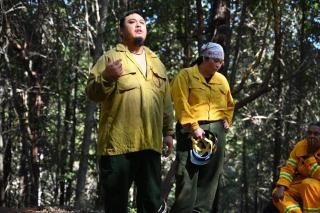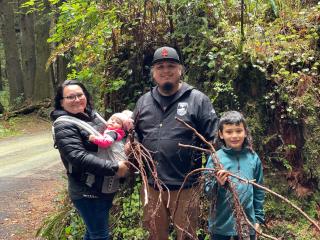Andrew Avitt, Pacific Southwest Region, June 29, 2023

Long before recorded history, in a place now referred to as the Klamath River Basin in Northern California, the Karuk Tribe thrived along the riverbanks.
The Karuk have relied on the land and the water for their spiritual and physical livelihoods. They developed rich traditions using fire to take care of the land.

As those tribal practices evolved so did the landscape—both needed each other, both needed fire.
Beau Goodwin, a Karuk Tribal member, is not sure when he first experienced fire, but he was likely just a baby.
“My dad was a ceremonial leader. So, as far back as I can remember, I was around ceremonial fire,” he recalled. Fire to me is healing. When I go out and put fire on the ground, when I tend to the land with fire, it’s what my people have done for millions of years, it’s healing my soul.”
Today that practice is called cultural burning. Cultural burning uses fire as a tool to restore balance to the land and to cultivate resources. Cultural fire was and is still considered critical by tribes to cultivate materials and food that are essential to centuries-long traditions and taking care of the resources.
Cultural burning can also moderate wildfire intensity and reduce risk to communities, something that land managers like the Forest Service have been working toward for decades using prescribed fire.
But land managers didn’t always see fire in such a positive light.

An Old Solution to an Old Problem
While some tribes have used fire as a way of life to benefit people and ecosystems since the beginning, those benefits were not so apparent to others.
Early settlers outlawed cultural burning by tribes and sought to exclude fire completely from the landscape. Those same fire exclusion policies would be enforced into the mid-20th century and are thought to be one major factor contributing to the intense wildfire behavior across the country in recent years.
“We’re getting to the point where Western science is starting to line up with cultural knowledge,” said Goodwin. “They’re starting to gather empirical evidence that supports what the native folks have been saying, what I already knew and believed– if we put fire on the ground, at the right time of year we will have multiple gains, for resources, wildlife and communities.”
In addition to Goodwin’s experience as a cultural practitioner of fire, he has worked in wildland firefighting for 15 years and is now an engine captain on the Six Rivers National Forest. It was an unlikely path, he said, but his experience has been encouraging.
An Unlikely Path and Future Relations

“I never saw myself working for the Forest Service,” said Goodwin. “When I was younger there was always this mentality at the Forest Service against the tribes. They didn’t get along very well. Maybe it was mismanagement or not having the same ideals.”
Goodwin grew up watching his father and fellow tribal members struggle to be heard.
“For years my dad battled the Forest Service trying to protect sacred sites, the fisheries and the water. He went head on with a lot of national forests in California,” he said.
But in the past five years Goodwin has seen a shift in how the Forest Service and Karuk Tribe have worked together.
“Now tribes have a seat at the table where in the past they had to fight to get to that table. Now the Tribe plays a huge role in managing their ancestorial territory. The relationship has come a long way,” he explained. “So, for me, seeing and listening to my dad’s struggle and then for me to walk in and have a seat at the table makes me feel hopeful for the relationship going forward.”
Resource Advising: Protecting Cultural Resources
Goodwin has a unique role when it comes to being a member of the Karuk Tribe and a Forest Service employee. His intimate knowledge of the landscape, locations of valuable cultural places, plants, species and ceremonial grounds makes tribal members like him ideal advisers for the Forest Service as they attempt to protect resources.
That very same expertise is also essential when the area is affected by wildfire that requires large incident management teams of hundreds of firefighters and support personnel to contain it.

“During these large-scale fires, it’s common to have personnel responding from across the country,” said Goodwin. “It’s part of a resource adviser’s role to make sure responders are aware of places that need to be protected from an oncoming wildfire and from firefighting tactics themselves, such as where build fuel breaks, retardant drops and operating heavy equipment.”
“For incident management teams, protecting life and property have always been top priorities when it comes to fighting wildfires,” he said. “Now protecting cultural resources is a piece of those top priorities, whereas maybe in the past they were not.”
Restoring the Forest, Relationships
As an engine captain, Goodwin plays a major role in bringing Forest Service and tribal firefighters together. Whenever possible, he aims to include tribal crews.
“They help us get the work done,” said Goodwin. “They help with thinning, pruning and piling. And when they come to our burns, we invite them to be the torch bearers to put the fire back on their ground to help restore that relationship.”
Together they implement prescribed/cultural burns. They also burn for cultural benefits like supporting the growth of bear grass, hazel and other basket materials.
Tribes in Northwest California have some of the best basket makers in the world. But to make these baskets, they must have the right quality materials.

“Oftentimes those ladies and men follow the smoke and so they travel great distances to large fires to find these basket materials,” said Goodwin. “Here we have an opportunity to put those materials in their backyards. As I’m doing my job as a steward of the land, why not give back to the community to continue building these baskets and preserve that cultural and traditional knowledge?”
Now the Six Rivers National Forest collaborates with tribal basket weaver’s and asks where and when would be the best time to burn to produce those materials. Then firefighters locate those areas and plan to burn there in the future.
“I have a daughter that is going to be a weaver someday,” said Goodwin. “It’s my job to make sure that she has the materials so she can become a weaver. Without fire, there will be no weaving. And that’s the truth.”
With the many benefits that fire can bring to people and the land – healthier ecosystems, cultural resources, preserving traditions for future generations, protecting sacred sites – there is much common ground between the Forest Service and tribes.
“It’s important for us to work together because in the end, we’re looking for one huge result, which is not having catastrophic wildfire on the landscape,” he said. “We’ve been here caring for Mother Earth since the beginning of time. We know to take care of her and she’ll take care of you.”
Originally posted on the Forest Service website.